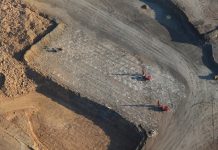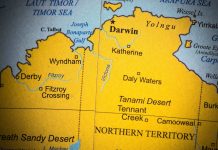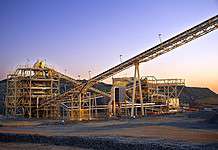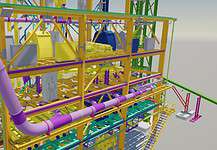 HAVING successfully raised $10 million through a share placement earlier this year, emerging heavy mineral sands company Sheffield Resources is well funded for a busy year ahead. Concentrating on its Dampier zircon project near Derby in the Kimberley region and a feasibility study for its large Eneabba heavy mineral sands operation near Geraldton, Sheffield is in a sound position to make 2012 a standout year.
HAVING successfully raised $10 million through a share placement earlier this year, emerging heavy mineral sands company Sheffield Resources is well funded for a busy year ahead. Concentrating on its Dampier zircon project near Derby in the Kimberley region and a feasibility study for its large Eneabba heavy mineral sands operation near Geraldton, Sheffield is in a sound position to make 2012 a standout year.
Sheffield’s projects are all in WA and are all wholly-owned. As well as the Dampier and Eneabba projects, it owns the large-scale McCalls chloride ilmenite project 110km north of Perth, seven granted tenements and nine tenement applications at the Pilbara Iron Project, and 1152 square kilometres of tenements in the Moora Talc Belt. Exploration programs are being undertaken at both Pilbara and Moora. Sheffield also owns the Berthas Butt tungsten project 40km north of Halls Creek, which is available for joint venture.
The company’s placement of around 30 million shares at $0.30 each,to institutional and sophisticated investors, was completed in February to fund exploration programs for 2012 and beyond. While the majority of the money will be spent on advancing the Dampier and Eneabba projects, Sheffield reported in an ASX announcement that it would also undertake further drilling, mineral assemblage and scoping work at its McCalls site. This work would focus on better understanding the distribution of the high-value minerals zircon and rutile, and definition of high-grade zones.
“Until recently, Sheffield has very much flown under the radar, however, with the rapid advancement of the Eneabba project, the recent granting of tenements in our Dampier zircon project, this $10 million funding and our planned active drilling programs, we expect this to change in 2012,” Sheffield managing director Bruce McQuitty said in the announcement. Dampier zircon Sheffield’s Dampier project comprises granted exploration licence E04/2083 and applications for E04/2081, 2082 and 2084, which together cover 1314sqkm. The project has a large-scale, high-grade and high in situ zircon content, with Sheffield estimating an exploration target of between 450 million tonnes and 850mt of ore grading 5 to 10 per cent heavy minerals.
The project area was previously explored by Rio Tinto between 2004 and 2009, with four broadly-spaced aircore drilling traverses identifying two zones of significant heavy mineral concentration. The first, Thunderbird, is a large, shallow, eastern zone. The second, Argo, is a smaller, deeper, western zone. Results from this drilling included: 45m grading 9.85 per cent heavy minerals from 3m, 27m grading 7 per cent heavy minerals from 1.5m and 27m grading 7.92 per cent heavy minerals from 9m at Thunderbird; and 12m grading 3.49 per cent heavy minerals from 42m and 7.5m grading 3.44 per cent heavy minerals
from 27m at Argo.
Sheffield’s exploration target, which it announced in November 2011, centres solely on the Thunderbird prospect, and is based on eight holes drilled by Rio. Within the exploration target area, the mineral assemblage averages 8 per cent zircon, 2.3 per cent rutile, 6 per cent leucoxene, 16.9 per cent altered ilmenite and 16.6 per cent ilmenite, based on the average of 63 samples analysed during Rio’s exploration period.
In Sheffield’s December quarterly report, the company stated that it would undertake Aboriginal heritage surveys at Dampier as soon as possible after the end of the wet season and ahead of an aircore drilling program aimed at enabling the estimation of an inferred resource and the undertaking of metallurgical work. It later reported that this program would comprise 1250m of aircore drilling, with an expected start
date of June 2012. Sheffield expected to undertake resource estimation in late 2012.
Eneabba heavy mineral sands The six advanced exploration targets that comprise Sheffield’s Eneabba project – West Mine North, Ellengail, Yandanooka, Durack, Drummond Crossing and Irwin – have a combined mineral resource of 41mt of contained heavy mineral sands.
The most valuable mineral components of heavy mineral sands can be classified as zircon and titanium minerals (rutile, ilmenite and leucoxene). According to Sheffield’s website, demand for titanium minerals
and zircon has been fairly steady historically, showing GDP-related growth characteristics. However, increasing demand for mineral sand products from developing countries has become progressively more evident during recent years. Titanium minerals and zircon constitute a relatively secure input source to a range of industrial and end-consumer applications, with relatively low threats from substitutes. Sheffield aims to develop multiple heavy mineral sands deposits within the project that are capable of supporting a sequential mining operation with a flexible mobile plant. The project area is well suited to this aim as it is in close proximity to existing mineral sands operations and a network of highways and railway lines connecting to the Geraldton and Fremantle/Kwinana ports.
On March 30, Sheffield released positive scoping study results for the advanced projects at Eneabba. “The scoping study results show the Eneabba project is potentially a financially-attractive operation, even based on significantly lower product prices, while additional exploration discoveries of near-surface mineralisation would further improve the project economics,” Mr McQuitty said in the release.
The study was based on mining operations starting at the largest prospect, Yandanooka – which has an indicated and inferred resource of 71.75mt grading 2.6 per cent heavy minerals for 1.84mt of contained heavy minerals, before progressing to West Mine North (with a measured and indicated resource of 42.5mt grading 2.8 per cent heavy minerals for 1.2mt of contained heavy minerals) and then Ellengail (with an inferred resource of 46.45mt grading 2.2 per cent heavy minerals for 1.04mt of contained heavy minerals). The heavy mineral concentrate would be produced at the mine sites and transported to a basic separation plant that Sheffield would construct near Geraldton. The proposed operation would produce 110,000 tonnes per annum of chloride-grade ilmenite and 70,000tpa of non-magnetic concentrate (containing rutile, leucoxene and zircon).
The scoping study confirmed the technical and robust financial viability of the project, which could achieve a mine life of 16 years. The total capital costs were estimated at US$75 million,based on an assumed flow sheet typical of similar operations in the industry. Predicted costs were minimised through the use of existing infrastructure, contract mining and the construction of a basic mineral separation plant. “It is important to note that this scoping study incorporates a low cost, basic mineralised separation plant and, therefore, it is assumed that the rutile and zircon concentrate, which would generate 67 per cent of the revenue, would be sold at a 25 per cent discount to prevailing prices. With further exploration success we aim to build a resource inventory that will justify a full MSP [mineral separation plant], which will allow us to realise greater value still from the operation,” Mr McQuitty said. He added that the company would commit to pre-feasibility studies at Eneabba while continuing to explore for near-surface, dunal-style deposits to increase the project’s potential. “Our strategy is to delineate a series of deposits at Eneabba that can underpin a 20 to 30 year mine life,” Mr McQuitty said.
The pre-feasibility work was launched in early April and is scheduled for completion by the fourth quarter of 2012. Also in April, Sheffield started a four-month drilling campaign targeting the Durack, Drummond Crossing and Irwin deposits, with the aim of delineating mineral resources to further improve the project’s economics.
Additionally, Sheffield reported that it would undertake further drilling at Yandanooka aimed at increasing the amount of the resource in the indicated classification. A short drilling program is then scheduled for McCalls before the rig is mobilised to the Dampier project. McCalls North of Perth near Gingin, the McCalls project has an inferred resource of 4.4 billion tonnes grading 1.2 per cent heavy minerals for a contained 43mt of chloride ilmenite and 3.5mt of zircon. It is in good proximity to existing infrastructure and comprises three granted exploration licences covering 471sqkm. BHP Billiton explored the project area in the early 1990s, outlining a large, low-grade deposit. Further investigation by Sheffield led to the announcement of the maiden inferred resource in February 2012, and confirmed the project as one of the largest accumulations of chloride-grade ilmenite in the world.
At the time, Mr McQuitty said that the mineral resource had far exceeded the company’s expectations in terms of size and contained tonnages of zircon and ilmenite.
“We regard McCalls as a strategic asset with potential to deliver a consistent long-term supply of feedstock for chloride route or synthetic rutile processing,” he said.
“This sizable maiden resource at McCalls, together with our large-scale, zircon-rich Dampier project and a growing [heavy minerals] resource base at Eneabba, firmly positions Sheffield as a fast-emerging and significant minerals sands company.”
By Rachel Dally-Watkins

























